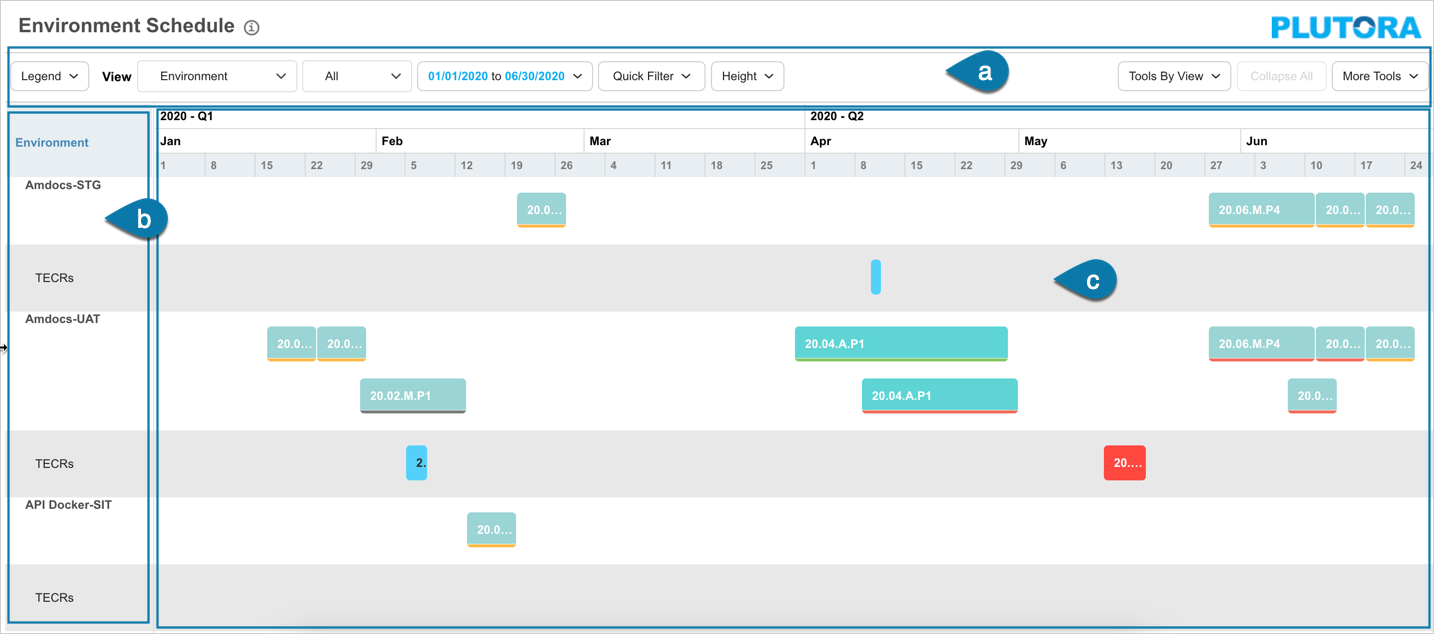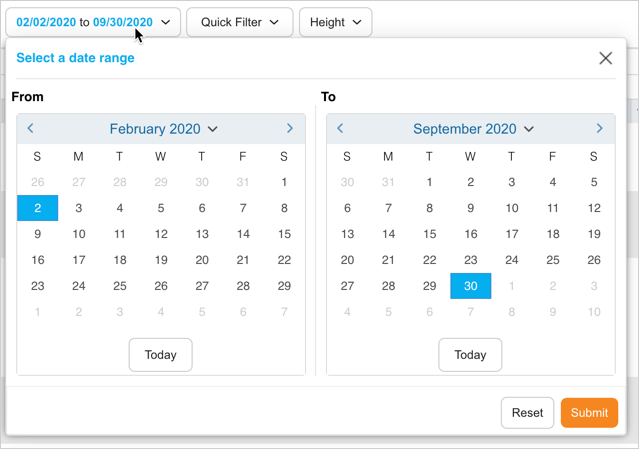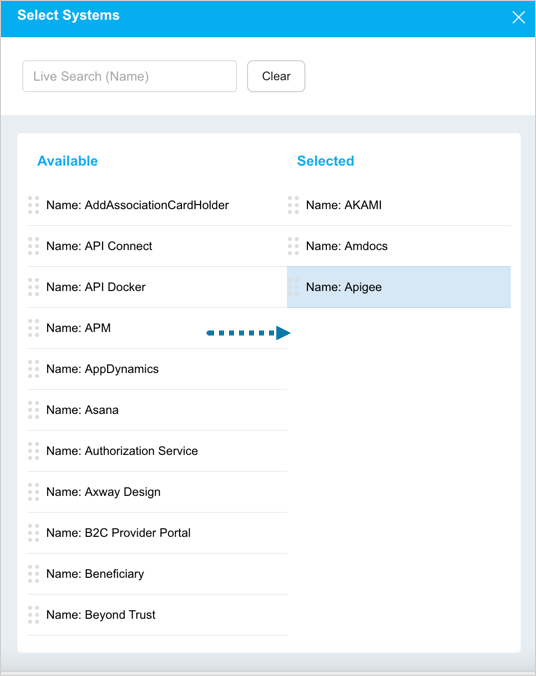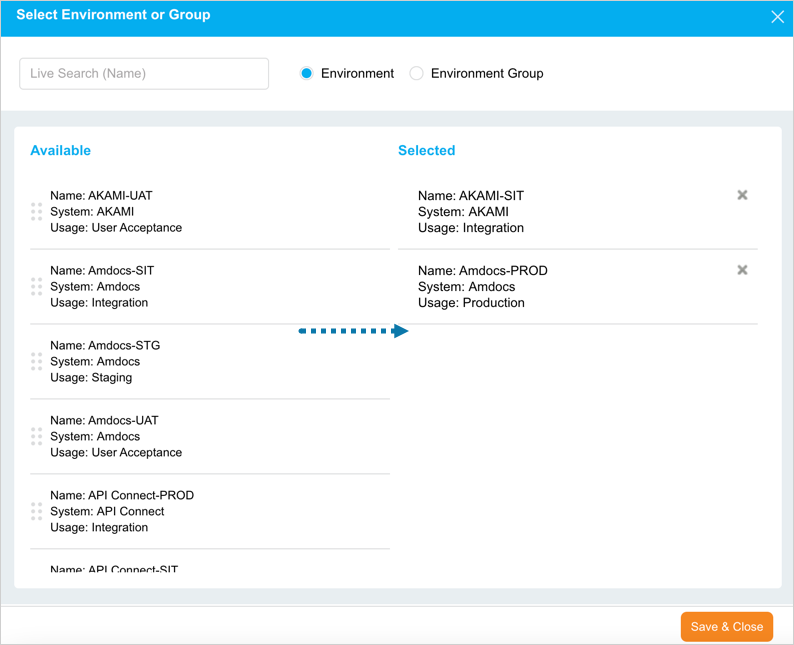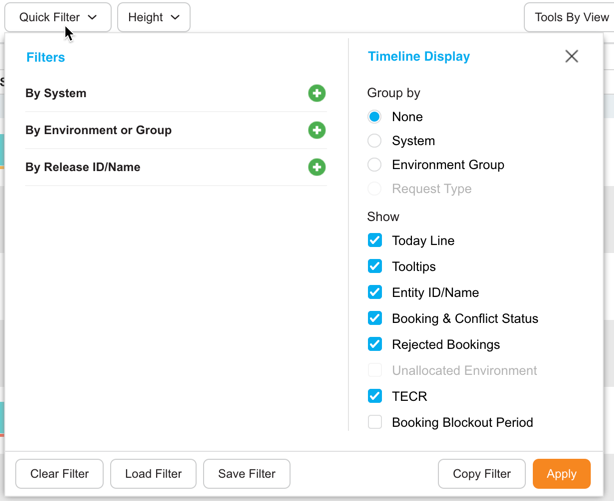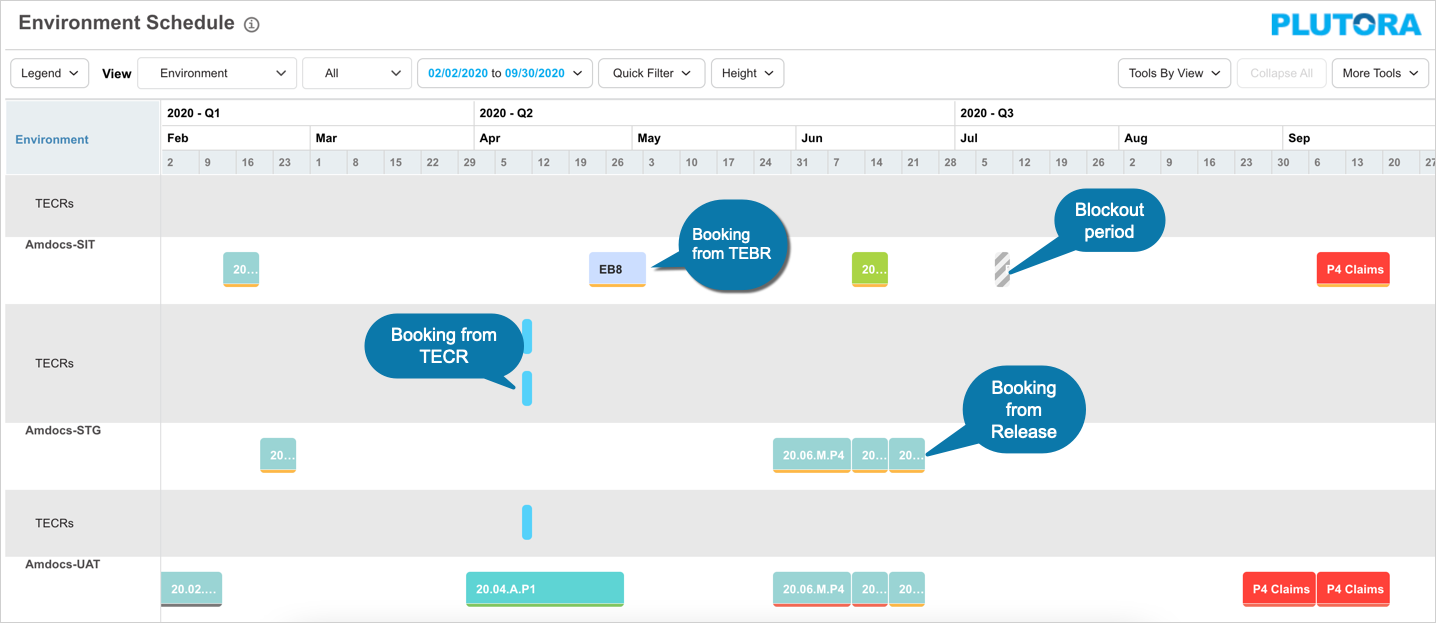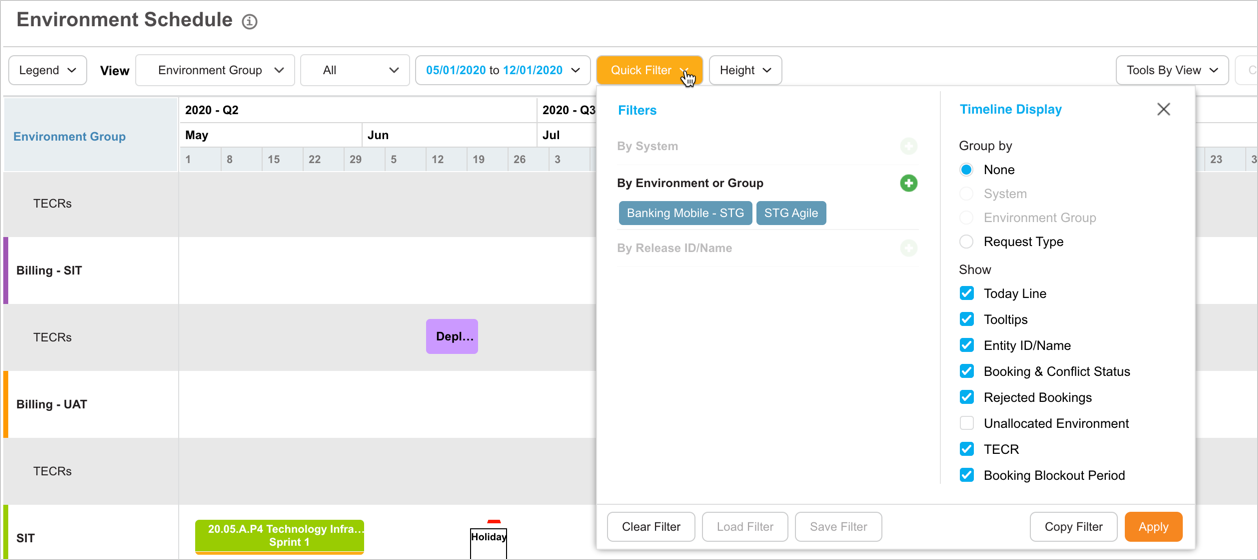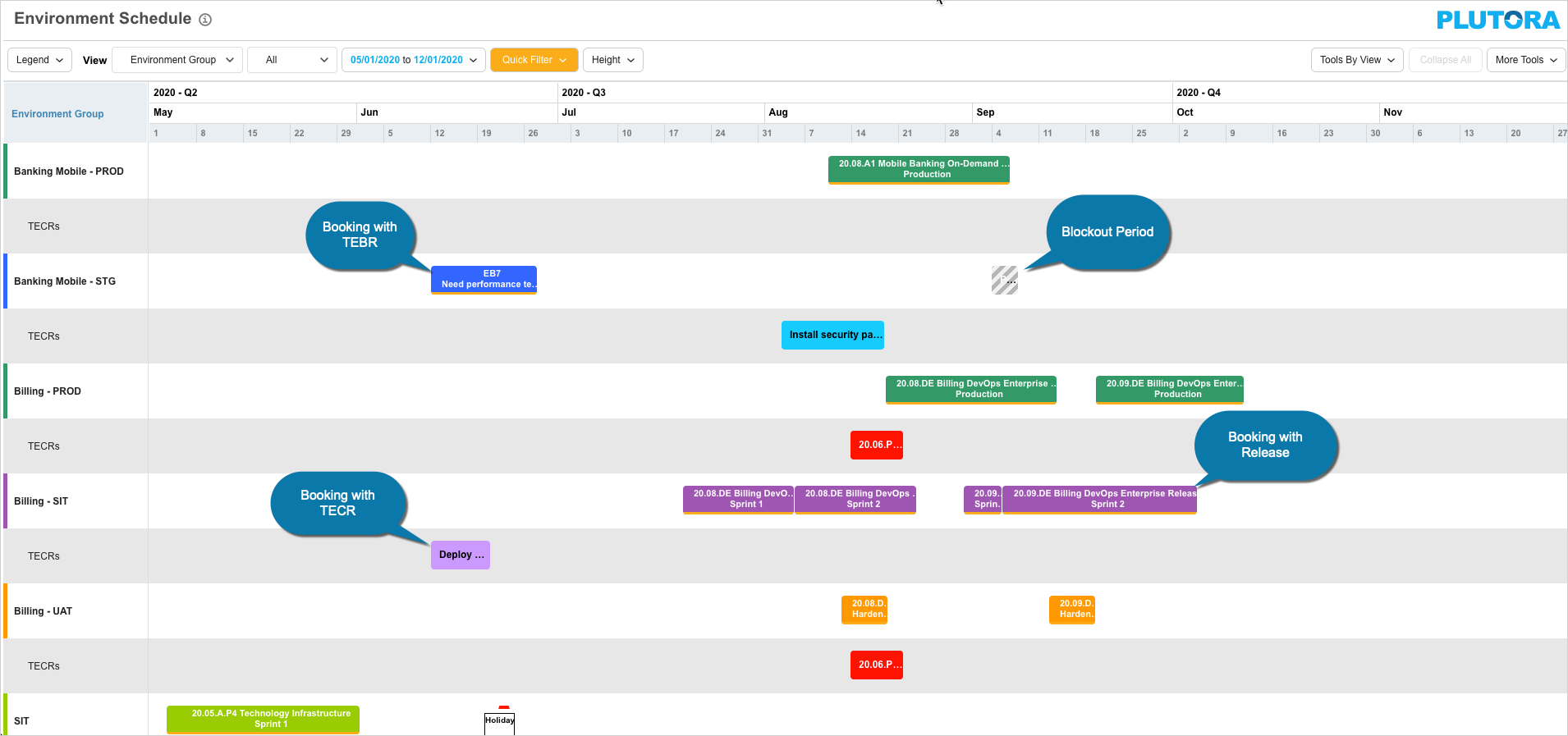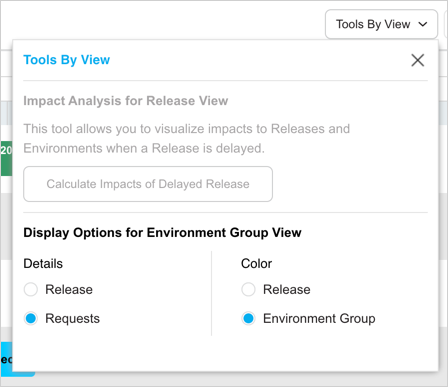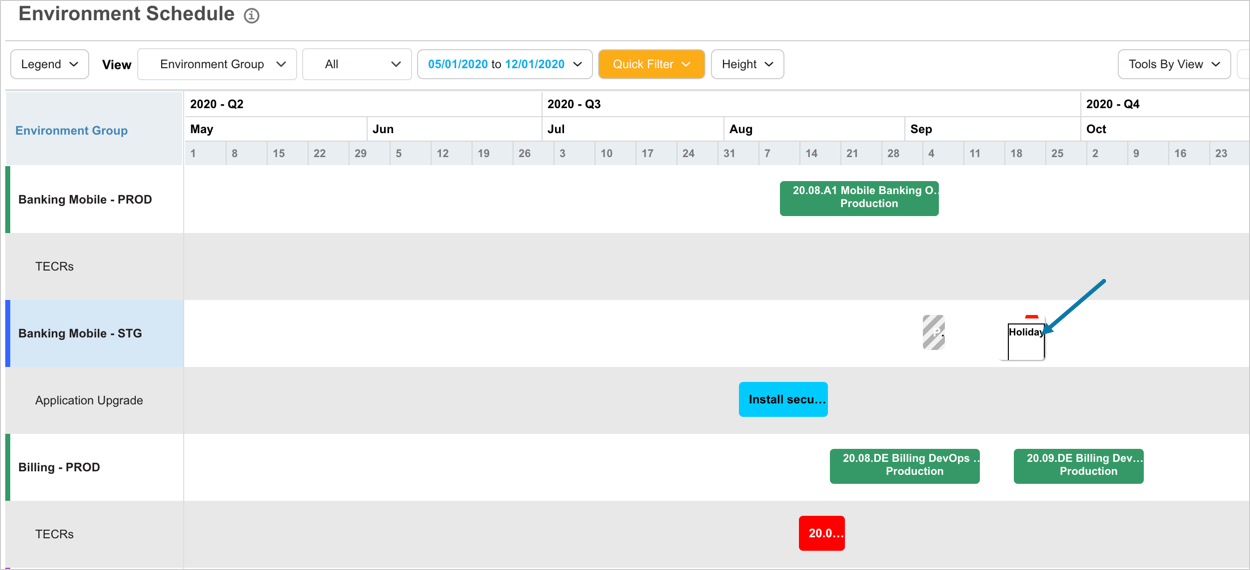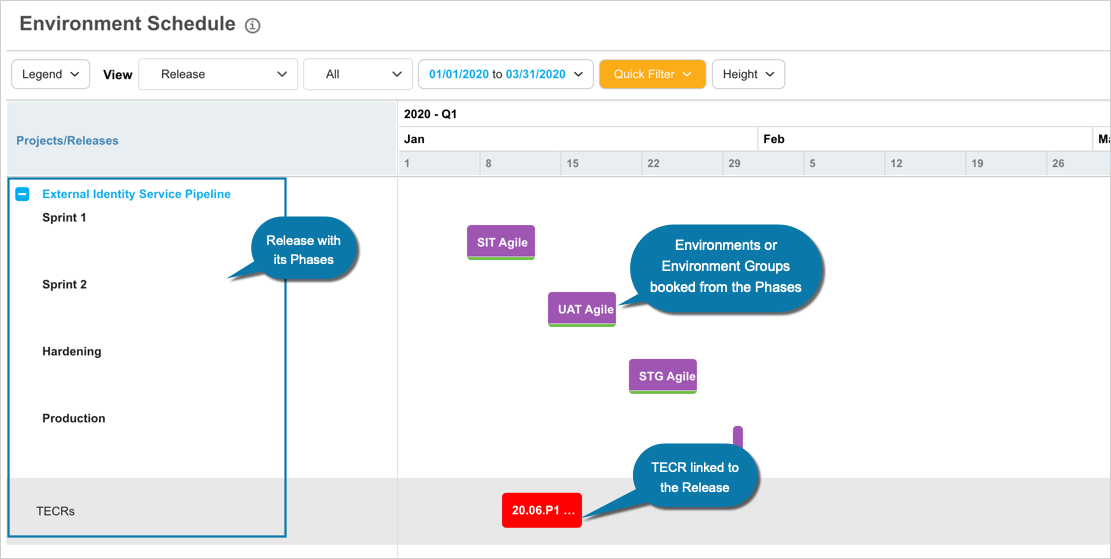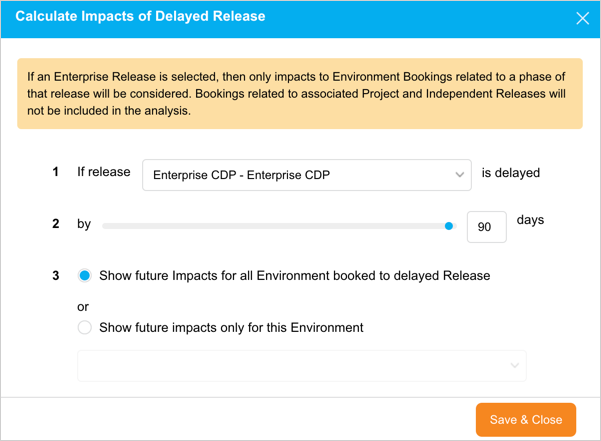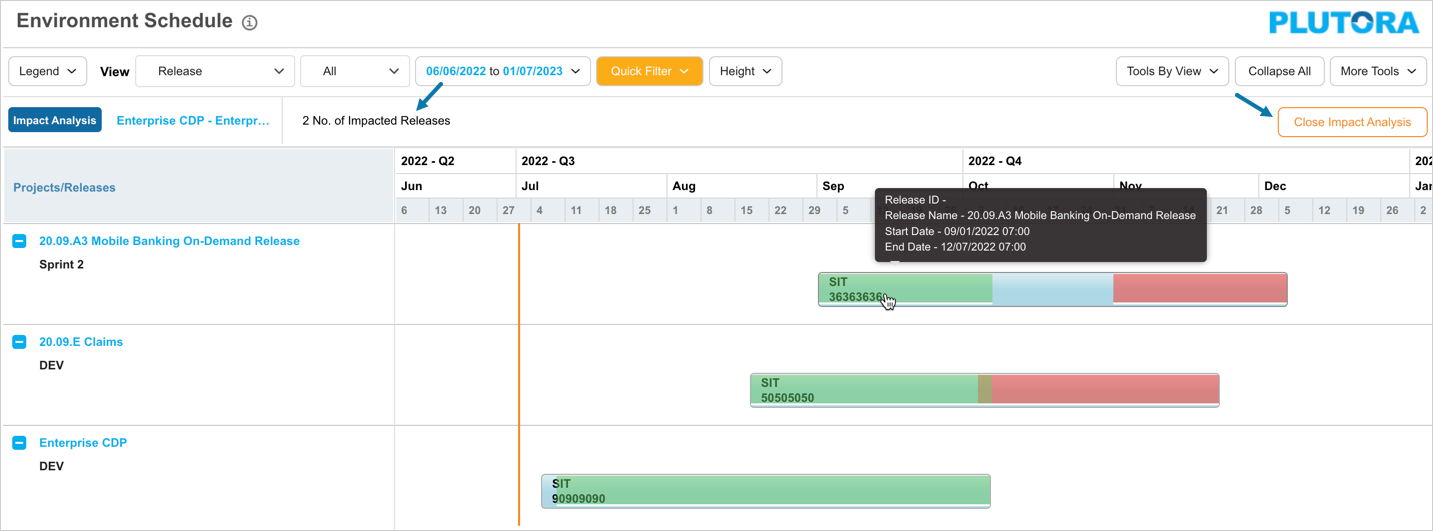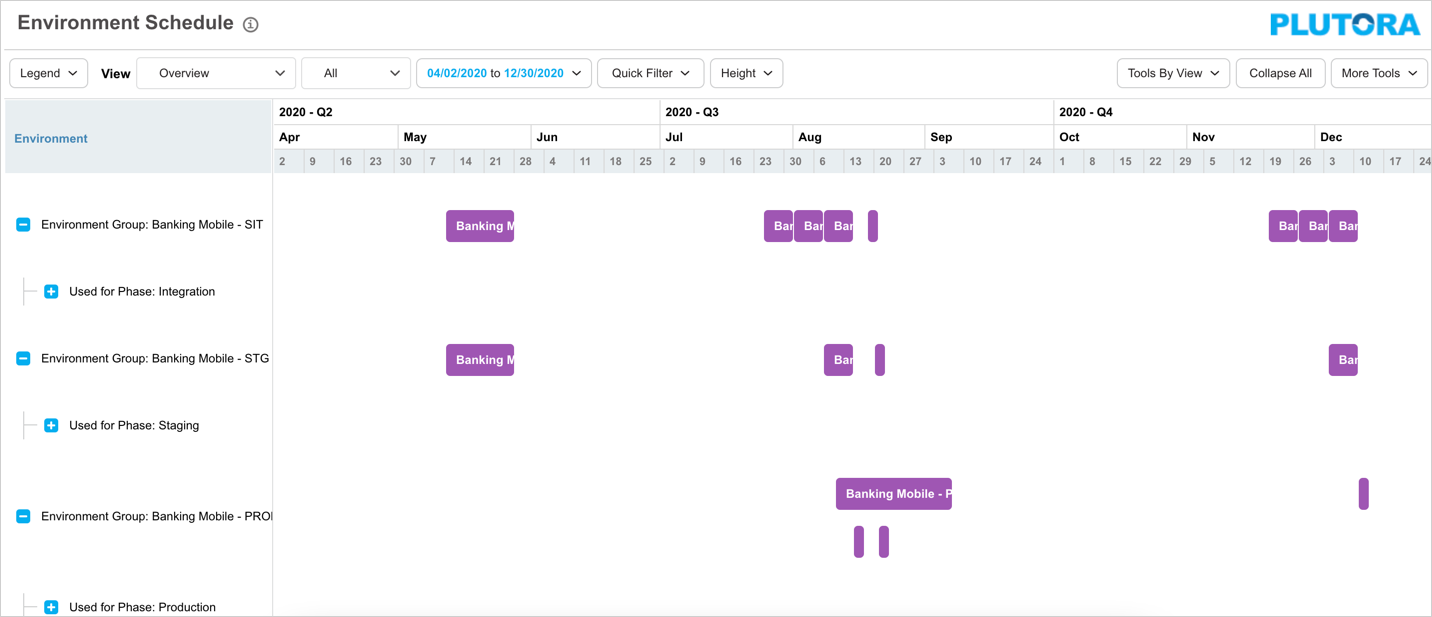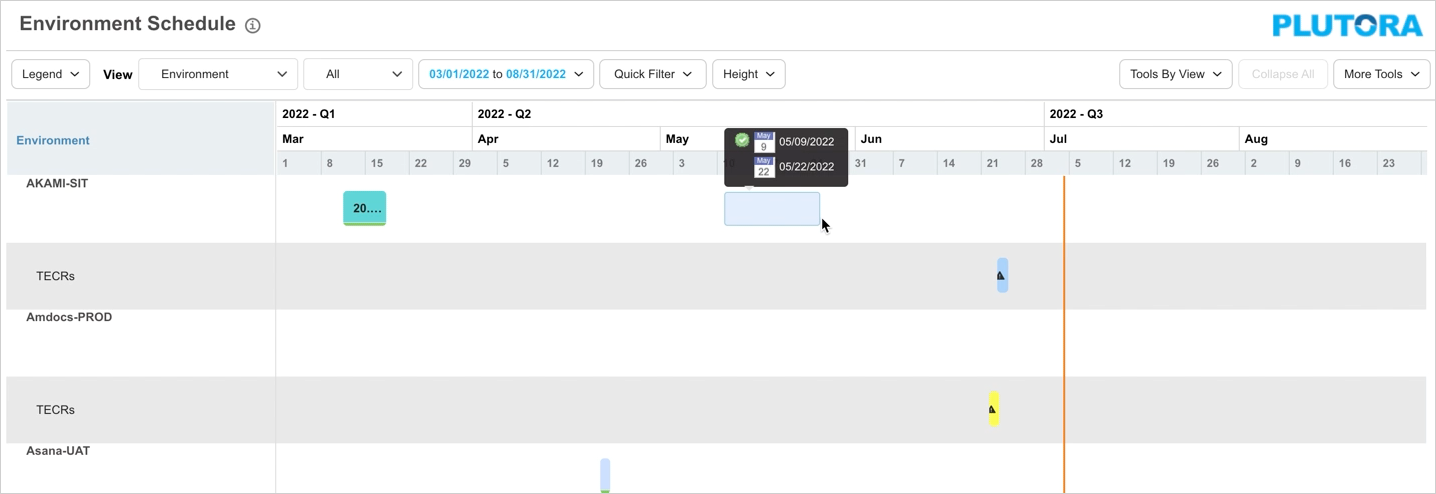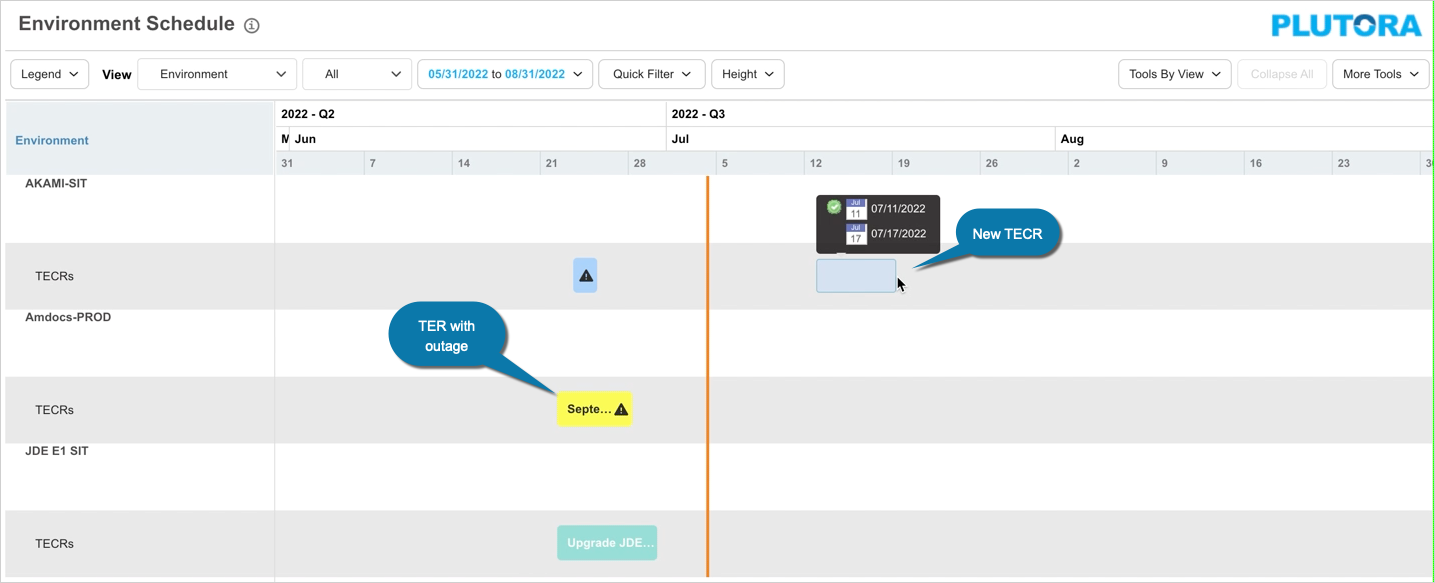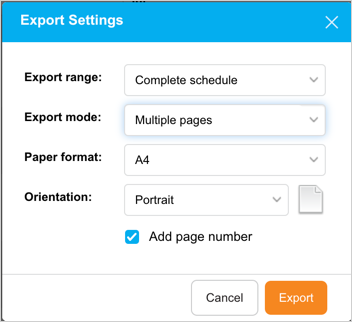Introduction
The Environment Schedule page allows users to find and fix conflicting Environment Bookings by providing four different views from the View drop-down menu:
- Environment View: Environment Bookings and TECRs by Environment.
- Environment Group View: Environment Bookings and TECRs by Environment Group.
- Release View: Environment Bookings and TECRs by Release and their Phases.
- Overview: Environment Bookings and TECRs by Environment Group, Environment Phase, Environment System, and Environment.
Pre-requisite
- You must have ‘View Environment Manager’ user permission to view the Environment Schedule.
- The following user permissions are required to add and edit TECRs, TEBRs, and Environment Bookings on the Environment Schedule:
- Approve Environment Allocation in Scheduler.
- Create Environment Allocation in Scheduler.
- Delete Environment Allocation in Scheduler.
- Create Environment Booking Request.
- Delete Environment Booking Request.
- Update Environment Booking Request.
- Create Environment Change Request.
- Delete Environment Change Request.
- Update Environment Change Request.
Navigation
Environment Schedule Page Layout
a: Filter and view options on this page.
b: Displays Environments, Releases, Release Phases, and Systems depending on the selected view.
c: Timeline displaying the data based on the filter and view.
Legend
Click Legend to view the color codes to identify and read the data that is being displayed on the schedule.
Use ![]() to view the complete list of legends available. The legend displayed is relevant to the data displayed on the timeline.
to view the complete list of legends available. The legend displayed is relevant to the data displayed on the timeline.
Filter Options
You have the following filter and view options available:
View
Allows you to choose from the four views so they can you can view and find and fix conflicting Environment Bookings:
- Environment View: Environment Bookings by Environment.
- Environment Group View: Environment Bookings by Environment Group.
- Release View: Environment Bookings by Release.
- Overview: Environment Bookings by Environment Group, Environment Phase, Environment System, and Environment.
Timeline Scale
Allows you to switch between timeline scales:
- All.
- Daily.
- Weekly.
- Monthly.
- Quarterly.
- Yearly.
Date Range
Allow you to select the earliest and latest items that will appear in the timeline. Select a date from the From and To calendars then click ![]() or click
or click ![]() to select today’s date.
to select today’s date.
Quick Filter
Click Quick Filter for the following filtering options:
Filter
This option allows you to filter (depending on the selected View) By System, By Environment or Environment Group, or By Release ID/Name. Not all filters are available for each view. The unavailable filters are grayed out.
To filter by System, Environment, Environment Group, Release ID, or Release Name, click Quick Filter and then click one of the ![]() .
.
Systems:
Drag and drop the Systems from ‘Available’ to ‘Selected’ then click ![]() . You can search for the Systems on the Live Search.
. You can search for the Systems on the Live Search.
This option is disabled for Environment Group View
Environment or Group:
Click Environment or Environment Group. Drag and drop the Environment/Group from ‘Available’ to ‘Selected’ then click ![]() . You can search for the Environment/Group on the Live Search.
. You can search for the Environment/Group on the Live Search.
Release ID/Name:
Click the following checkboxes to filter. Drag and drop the Releases from ‘Available’ to ‘Selected’ then click ![]() . You can search for the Releases on the Live Search.
. You can search for the Releases on the Live Search.
This option is disabled for Environment Group View.
Save Filter
To save your filters (but not grouping or display options) so they can be loaded later,
- On ‘Quick Filter’ click
 .
. - Type a Filter Name.
- Type a Description.
- Select a Viewable by radio button.
- Click
 .
.
Load Filter
To load a saved filter:
- On ‘Quick Filter’ click
 .
. - Select one of your saved filters from the My Filters drop-down menu or
- Select a public filter from the Public Filters drop-down menu.
- Click Apply Filter.
Only saved filters are loaded. Not grouping or display options.
Copy Filter
Click ![]() to copy the link to Environment Schedule that contains all your filters and settings. Then paste the URL into an email or another document.
to copy the link to Environment Schedule that contains all your filters and settings. Then paste the URL into an email or another document.
Timeline Display
The grouping and display options will be grayed out if they are not available for the selected view, or if the selected filters have not found any data.
Group by
Select a ‘Group by’ option to group the data on the timeline.
Show
- Today Line: The Today Line shows the current day in the timeline.
- Tooltips: Tooltips are the boxes of information that appear when you hover your mouse cursor over a Release, a TEBR without a Release, a TEBR with Release, or a TECR in the timeline.
- Entity/ID Name: Toggle between displaying the name or title of an item or its ID.
- Booking & Conflict Status: This shows the status of bookings as a colored line along the bottom of a booking. Set to a bright red if conflicts exist.
- Rejected Bookings: Toggle between displaying or hiding bookings that have been rejected.
- Unallocated Environments: Toggle the display of Environments that haven’t been allocated. This option is only available in Environment or Environment Group View while you have a filter applied for Systems, Environments, or Environment Groups. The purpose of this filter is to show Environments that are available during a selected time period.
- TECR: Toggle the display of the TECR rows. TECRs display a triangular icon when they contain an outage.
- Booking Blockout Period: This shows a time period when that Environment or Environment Group cannot be booked. Booking Blockout Period appears when a Blockout has the Category ‘Environment Booking’.
Height
Allow you to increase the height of rows and item bars in order to improve visibility.
Tools by View
Impact Analysis: This tool is enabled only for the ‘Release View’ option. For details, see Impact Analysis.
Booking Display Options: This tool is enabled only for ‘Environment Group’ View. For details, see Booking Displays Options.
Collapse All
This option is disabled unless it is possible to collapse the records in the left-hand column. For example, Releases in Release View. If selected, it changes to Expand All.
More Tools
Click More Tools for the option to export the current Environment Schedule view to PDF or View Full Screen.
Environment View
Select Environment View from the ‘View’ drop-down. The Environment View displays:
On the Left-hand column depending on the Group By selection from the ‘Quick Filter’:
- None: Environments.
- System: Environments grouped by Systems.
- Environment Group: Environments grouped by Environment Groups.
- Request Type: Grayed out in this view.
Clicking an Environment in the left-hand column opens the ‘Edit Environment’ pop-up. To edit an Environment, see Add/Edit Environment.
In the Timeline are:
- Bookings from Releases: Clicking them opens the ‘View/Edit My Environment Booking’ pop-up. Open the linked Release from the link in the pop-up. Users with the ‘Approve Environment Allocation in Scheduler’ user permission can approve or reject Environment Bookings. To prevent Environments from requiring approval, set them to auto-approve. The color of the bar is from the Release Type. Example shown in the below image.
- Bookings from TEBRs (with or without a Release): Clicking them opens the ‘View/Edit My Environment Booking’ pop-up. You can open the linked TEBR in the pop-up by clicking on it. Approve or reject the booking if you have the ‘Approve Environment Allocation in Scheduler’ user permission. Example shown in the below image.Hover your mouse cursor over TEBR bars to open the tooltip to display the TEBR Requester and TEBR Type details. The default color for TEBRs without a Release is light blue. TEBR with a Release shows the Release Type color. Example shown in the below image.
- TECRs linked to the Environment: You can display the TECRs by checking the checkbox TECR in the ‘Show‘ option in ‘Quick Filter’. Clicking them on the timeline opens the ‘TECR’ pop-up. For more information, see View/Edit/Add TECRs. Example shown in the below image.
- Environment Booking Blockouts: Environment Booking Blockouts show time periods when an Environment or Environment Group cannot be booked. For details on blackouts, see Blockouts. Example shown in the below image.
- Use Legend to read the data displayed on the timeline.
- Filter the data displayed on the timeline using the Filter Options.
Environment Group View
Select Environment Group view from the ‘View’ drop-down. The available Quick Filter options on this view are:
- Filters: Only the ‘By Environment or Group’ filter is available. ‘By System’ and ‘By Release ID/Name’ will be disabled.
- Timeline Display:
- Group By: ‘None’ (Environment Groups will be listed without grouping) and ‘Request Type’ (Environment Groups will be listed without grouping) are available for filtering. Other options are disabled in this view
- Show: All the options will be available for filtering. For details, see Show.
In the Timeline are:
Bookings from Releases: Clicking them opens the ‘View/Edit My Environment Booking’ pop-up. Open the linked Release from the link in the pop-up. Users with the ‘Approve Environment Allocation in Scheduler’ user permission can approve or reject Environment Bookings. To prevent Environments from requiring approval, set them to auto-approve. The color of the bar is from the Release Type. An example is shown in the below image.
Bookings from TEBRs (without a Release): Clicking them opens the ‘View/Edit My Environment Booking’ pop-up. You can open the linked TEBR in the pop-up by clicking on it. Approve or reject the booking if you have the ‘Approve Environment Allocation in Scheduler’ user permission. An example is shown in the below image.
TECRs linked to the Environment Group: You can display the TECRs by checking the checkbox TECR in the ‘Show‘ option in ‘Quick Filter’. Clicking them on the timeline opens the ‘TECR’ pop-up. The color of the TECR is from TECR Type. For more information, see View/Edit/Add TECRs. An example is shown in the below image.
Environment Group Blockouts: Blockouts show time periods when an Environment Group cannot be booked. Hover over the Blockout to view the tooltip with details. For details on blockouts, see Blockouts. An example is shown in the below image.
- Use Legend to read the data displayed on the timeline.
- Filter the data displayed on the timeline using the Filter Options.
Display Options for Environment Group View
To use the display options for the Environment Group view on the Environment Schedule:
With the ‘Environment Group’ view selected from View click Tools by View and look under Display Options for Environment Group View. Refer to the following table for the relationship between the display options:
| Details | Color | Behavior |
|---|---|---|
| Release | Release | TEBRs and Releases appear with the Release Color Scheme color from Environment Setup. |
| Release | Environment Group | Environment Bookings made through TEBRs that are associated with Releases are flagged with a triangle (that is 50% darker or lighter than the main color) on their bottom-left corner. Releases appear with their Environment Group color. |
| Requests | Release | TEBRs appear as rectangles that are the color of their TEBR Type, with a color bar at the bottom showing their TEBR Status color. Releases appear as rectangles showing their Release Color Scheme color from Environment Setup. |
| Requests | Environment Group | TEBRs appear as rectangles in the color of their TEBR Type, with a color bar at the bottom showing the color of their TEBR Status. Releases appear as rectangles showing their Environment Group color. |
Add/Edit a Schedule Marker
Schedule Markers are labeled bars that appear on the Environment Schedule under the Environment Group View. They can be used to represent events, deadlines or other date-based occasions.
- On the Environment Schedule page, with Environment Group selected from the ‘View’ drop-down menu, click on a vacant area on the timeline.
- The ‘Add New Schedule Marker’ pop-up opens. Enter the following:
| Fields | Description |
|---|---|
| Label | Enter a label for the schedule marker to be displayed on the Environment Schedule. |
| Date | Select a date and time for the schedule. |
| Created/Requester | Uneditable fields. Displays the requester details and the date when it was created. |
| Color | Select a color to be displayed on the Environment Schedule. |
| Show label on scheduler | Check this option to view this marker on the Environment Schedule. |
- Click
 .
.
To edit a Schedule Marker, click on the marker on the timeline to display the ‘Edit Schedule Marker’ pop-up. The update the fields as required.
Release View
Select Release view from the ‘View’ drop-down. The available Quick Filter options on this view are:
- Filters: Only the ‘By Release ID/Name’ filter is available. ‘By System’ and ‘By Environment or Group’ will be disabled.
- Timeline Display:
- Group By: All the options are disabled.
- Show: All the options except ‘Booking Blockout Period’ and ‘Unallocated Environment’ will be available for filtering. For details, see Show.
The left-hand column on the Release view displays Releases with their Phase(s). For more details on Release Phase and Gates, see Manage Phases and Gates.
In the Timeline are:
- Environments or Environment Groups booked from the Phases of those Releases: Clicking bookings open the ‘View/Edit My Environment Booking’ pop-up. Users with the ‘Approve Environment Allocation in Scheduler’ user permission can approve or reject Environment Bookings in Environment Schedule.
- TECRs linked to the Release (not the Phases): TECRs can be displayed by checking the TECR checkbox in the Quick Filter. Click to open TECRs.
Impact Analysis
To view the impacts that would occur if an Enterprise, Project or Independent Release is delayed:
- In the ‘Release’ view, click Tools By View.
- Click Calculate Impacts of Delayed Release.
- Select an Enterprise, Project, or Independent Release (which will all have an Implementation Date in the future) from the If release drop-down menu.
- Move the slider to select the number of days the Release will move. (You cannot type a number into the text field.) The maximum number of days is 90.
- Select either:
- Show future impacts for all Environments allocated to delayed Release or
- Show future impacts only for this environment. You can select the Environment after clicking the radio button.
- Click
 .
.
The Impact Analysis displays the list of Releases (and phase), with previously non-overlapping Bookings for the Environments, that are affected if the selected Release is delayed for the number of days you have entered.
- The header of the timeline displays No. of Impacted Releases due to the delay in Release.
- Hover over the bar on the timeline to display the tooltip to view the Release details.
- On the Impacted Release:
- Green blocks show the number of days the end date of the Booking would move forward by.
- Red blocks at the end of the booking show the number of days the booking will need to extend.
- Existing conflicts (from before the date adjustment) will also show in red and will have moved by the same amount of time as the overlap.
- On the Instigator Release:
- Green blocks show the number of days the booking will need to extend.
- It is assumed that the Instigator Release will be taking longer rather than completely shifting, so only the end dates are affected.
- Where there is a gap between bookings, the overlap will be the days of slippage minus the gap. For example, if a Release is pushed 5 days forwards, and there is a 3-day gap between one of its Bookings and another Release’s Booking of the same Environment, the later booking will only need to be pushed out by 2 days.
- Where a delay results in primary impacts on multiple Releases, all those Releases will be shown on the timeline.
- Impact Analysis only identifies primary impacted Releases. For example, if you move the dates of Release 1, Release 2 will be the primary impacted Release. Moving the dates of Release 2 might impact Release 3, but Release 3 will not be shown in the Impact Analysis of Release 1.
Click ![]() to return to the Release view.
to return to the Release view.
Overview View
Select Overview view from the ‘View’ drop-down. You can use the ‘Show’ option in Quick Filter for filtering the data displayed, the rest of the Quick Filter options are disabled.
This view reflects the component bookings through a tree structure so that you can make an informed decision on what is booked where.
Overview displays the following tree structure of values:
- Environment Group.
- Environment Phases (‘Used for Phase’ field from Environment).
- Environment System (‘System’ field from Environment).
- Environment.
- Environment System (‘System’ field from Environment).
- Environment Phases (‘Used for Phase’ field from Environment).
Due to the tree structure, Systems, Environments, and Environment Groups, the dependencies between them and all corresponding bookings for Environments and Environment Groups will be shown.
Add a New TEBR
You can create TEBR in Environment, Environment Group, and Release view. To create a new TEBR:
- Left-click on the timeline on the TEBR start date.
- Drag your mouse cursor along the timeline to the TEBR end date. The selected area is highlighted on the timeline between the first and last date selected. Edit TEBR pop-up opens so you can add more information about your booking.
View/Edit/Add TECRs
You can create and view the TECRs in Environment, Environment Group, and Release view.
The name and color of the TECR row are customized in Environment Schedule – TECR Row. TECRs display a triangular icon when they contain an outage.
To view TECRs:
- Toggle the TECR rows by selecting the TECR checkbox in the Quick Filter.
- Only TECRs that belong to the Environment will be displayed.
To edit a TECR: Click on the TECR in the TECR row. The Edit TECR pop-up opens.
To add a TECR:
- Left-click on the TECR row timeline on the TECR start date.
- Drag your mouse cursor along the timeline to the TECR end date. The selected area is highlighted on the timeline between the first and last date selected. Add TECR pop-up opens so you can add more information about your booking.
Export Environment Schedule to PDF
To export an Environment schedule to PDF:
- On the Environment Schedule page, filter your Environment Schedule using the filters in Filter Options.
- Click the More Tools drop-down.
- Click Export to PDF.
- Select a range from the Export Range drop-down menu:
- Complete Schedule: Whole schedule without filtering.
- Date Range: Select a date range.
- Current View: The current manually filtered view.
- Select an Export Mode.
- Single page: Compress the schedule to a single page.
- Multiple pages: Split the schedule into multiple landscape pages.
- Multiple pages (vertically): Split the schedule into multiple portrait pages.
- Select a Paper format
- Select an Orientation:
- Select the Add page number checkbox if you have selected multiple pages in Export Mode.
- Click
 .
.

